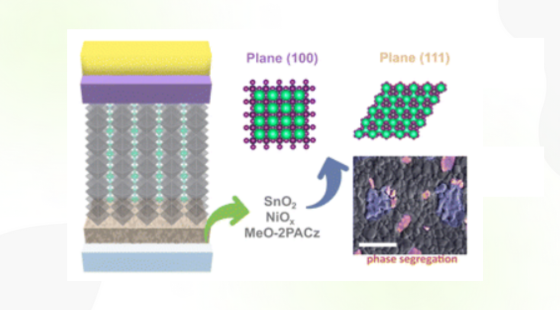Novel approach by CINE improves the stability of perovskite solar cells

Researchers from Unicamp and CNPEM have innovatively addressed the problem of instability in perovskite solar cells, presenting a new strategy to optimize these devices.
Metal halide perovskite films promise to be in the center of the next generation of solar cells with their excellent performance in converting sunlight into electricity. However, to fully exploit their potential, the stability of these materials in the face of heat and humidity still needs to be improved.
Composed of several thin layers, perovskite solar cells are similar to a sandwich in which the slices of bread are the electrodes and the filling consists of the light-absorbing layer (the perovskite film) and the transport layer, responsible for carrying electrical charges to the electrodes.
Many approaches to the problem of instability in these devices have already been researched, with varying results. However, in this new work, the authors offer a unique perspective by investigating how the quality of the perovskite film is influenced by the underlayer (the part of the transport layer that is in direct contact with the perovskite).
In fact, to produce a solar cell, a liquid solution containing perovskite components is deposited on the surface of this layer, where the perovskite crystallizes, forming a solid film whose grains align in specific crystalline orientations.
In this work, using different materials in the underlayer, the authors produced perovskite films with different crystalline orientations and subjected them to a temperature of 85°C for 500 hours.
“The main contribution of this study is to demonstrate, in a systematic and unprecedented manner, how different underlayers—fundamental in the architecture of conventional and inverted perovskite solar cells—directly influence the crystalline orientation of the metal halide perovskite and, consequently, its thermal stability,” says CINE postdoctoral fellow Murillo Henrique de Matos Rodrigues, one of the authors of the study.
Achieving this result was crucial thanks to the partnership between the Unicamp group, a pioneer in Brazil in the study of perovskite solar cells, and the CNPEM researchers, who enabled the use of advanced material characterization techniques. “This synergy has already resulted in several relevant studies in the field and strengthens the role of these institutions in the search for sustainable technological solutions in energy,” says Murillo.
The new research opens up exciting possibilities for optimizing the next generation of solar cells. “The in-depth understanding of the role of the underlayer represents a milestone for designing new transport layers that promote oriented growth, resulting in more efficient and durable devices—a crucial differentiator compared to previous studies,” emphasizes Murillo.
The work was funded by FAPESP, Shell, and CNPq, in addition to strategic support from ANP.
Paper reference: Murillo H. de M. Rodrigues, Diogo M. Guilhermitti Neto, Ingrid D. Barcelos, Cilene Labre, Carlos Alberto R. Costa, Joao Batista de Souza Junior, Josiane A. Sobrinho, and Ana Flavia Nogueira. The influence of the buried interface on the orientational crystallization and thermal stability of halide perovskite thin films. J. Mater. Chem. A, 2025,13, 17799-17809. https://doi.org/10.1039/D5TA01772F
CINE members who participated in the work: Murillo H. de M. Rodrigues (postdoctoral fellow), Diogo M. Guilhermitti Neto (master’s student), Josiane A. Sobrinho (postdoctoral fellow), and Ana Flávia Nogueira (researcher and director of CINE).
Contact

Ana Flávia Nogueira
UNICAMP

